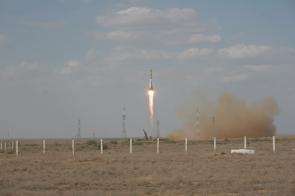MSU bacteria shivered on Russian space capsule

Geckos, snails and newts thrived on a Russian spacecraft that carried a Montana State University experiment last summer, but not bacteria, said an MSU microbiologist who is studying the long-term effects of space travel.
Barry Pyle said the bacteria didn't grow as fast as it should have, affecting the outcome of the experiment, because the unmanned Soviet Foton-M2 space capsule was five or 10 degrees too cold. He blamed a physics experiment that doubled as a heat source for the space capsule. Nevertheless, he said he learned a great deal that he'll use to prepare for next year's mission.
"We have learned a lot. We are really poised now to have a very successful re-flight and add to the scope of the experiment," said Pyle who is in Moscow now negotiating details and planning for Foton-M3. The mission is scheduled to launch from Kazakhstan in September 2007.
MSU's experiment was one of 39 that was launched May 30 last year from Kazakhstan and landed on June 16, 2005. MSU and the NASA Ames Research Center were the only U.S. institutions invited to participate in the project that originated with the Russian Academy of Sciences' Institute for Biomedical Problems, Pyle said. Other experiments were conducted by Russian or European scientists.
The experiment that failed to heat the space capsule came from another institution, but temperature is one factor that will need to be corrected in the next mission, Pyle said. He and his team of MSU researchers will also switch to a different strain of Streptomyces bacteria, S. coelicolor instead of S. lividans. Research associate Tresa Goins said the genetic sequence of S. coelicolor is known and will make it easier to interpret results. It will not only permit the detection and characterization of mutations, but it may also illustrate the effects of space flight on genetic exchange.
Pyle presented the Russian and MSU findings at a Japanese conference and submitted an article to the Journal of Gravitational Physiology.
"We didn't see any changes that appeared to be the result of microgravity or radiation," Pyle reported.
The process itself taught the group more about working with Russian scientists and the logistics of long-distance research, Pyle said. He and Ames Research Center scientists were accompanied to Moscow by a Russian translator who works for the National Aeronautics and Space Administration. One of Pyle's colleagues will visit MSU in August and September.
"It's interesting to receive samples that are so unique," Goins said. "They have been up in a satellite You don't get that opportunity every day."
MSU researchers began analyzing their bacteria samples after receiving them back last July. Pyle said their work is fundamental, basic research, but it could have commercial applications someday. The more immediate goal is learning if factors like radiation and microgravity affect the genes of organisms on long space flights.
"It's not like they mutate into some creepy monster," Pyle said. He added that changes are more likely to involve antibiotic resistance and disease-causing abilities.
Those involved in MSU's first experiment with Pyle and Goins were Susan Broadaway, laboratory manager; Vince Martinson of Huntley, a recent graduate who is now on an international quest for rare beetles; Elinor Pulcini at MSU's Center for Biofilm Engineering; Sarah Roth, research assistant; and Eli Hall, an MSU alum from Helena.
The snails, geckos and newts on Foton-M2 came from NASA Ames researchers, Pyle said. The snails were there for a study on balance. The newts and geckos were there because of their ability to grow new limbs.
The Foton-M2 was the second in a series of unmanned Russian missions. Pyle said it's an example of space flight research in the future, where every experiment is autonomous and can be operated without astronaut intervention or from the ground.
Source: Montana State University















